By Habeeb Salloum
On our farm in southwest Saskatchewan, of all the spices Mother used, there were a few with long histories that she never had in her kitchen. One of these was turmeric, a spice as old as time.
As I grew older and travelled the world, I enjoyed the cuisines of many countries, especially in the East. I found that turmeric is a spice that should have a home on every household shelf.
In the Indian sub-continent, China and the countries of Southeast Asia, turmeric has for centuries been used in cosmetics and medicine, as a vegetable dye, and above all, as food seasoning. In these ancient lands, this spice, also known as “yellow ginger” and “Indian saffron,” has always been used to flavor a wide variety of dishes. An essential condiment in the preparation of all types of curries, turmeric adds a warm, mild aroma and a brilliant yellow color to any food.
The turmeric plant is found wherever its sister plant, ginger, is cultivated. Grown for over 3,000 years its cultivation has now spread to most tropical regions of the world, especially the Caribbean lands and parts of South America. However, as in the past, India remains by far the largest producer and chief exporter of the spice.
Finger-like in appearance with a brown skin and bright yellow flesh, the turmeric root is aromatic, delicate, and has a slightly peppery taste that is clean and refreshing. After harvesting, the rhizomes are boiled, then dried and polished. Subsequently, they are either milled into powder or left whole and sold in that state, to be ground at time of use.
Modern research has established that turmeric has a beneficial effect on the liver, stimulating the flow of bile and the breakdown of dietary fats; protects against gallbladder diseases and helps prevent blood clots. Generally, doctors and herbalists recommend it as a potent anti-inflammatory, and for the pain and swelling of arthritis. In many Asian countries, turmeric boiled with sugar is used as a cold remedy, for flatulence, and liver ailments.
Curcumin is the main active ingredient in turmeric. Studies have shown that curcumin reduces inflammation and reverses damage caused by the build up of an amino acid that contributes to the growth of Alzheimer’s Disease. It may prove effective in delaying or even reversing many associated age-related decreases in brain function such as memory loss. And curcumin is beneficial for preventing and possibly even treating some cancers at the molecular level.
Turmeric is used extensively worldwide in the preparation of food, both in the home and commercially. Turmeric’s antibacterial properties meant it was put to use as a food preservative long before the widespread use of refrigeration. Commercially, the spice itself is extensively used to color butter, cheeses, chutneys, condiments, fruit drinks, margarine, mustard powders, pickled products, pudding mixes, and soups.
Sweeter and more fragrant than its sister ginger, turmeric is also often used as an economical substitute for saffron because it has a clean, slightly bitter taste, and adds a subtle flavor to food.
While turmeric is used in kitchens throughout the world as dried and ground rhizomes, in North America, the fresh roots can be found in many East and South Asian grocery outlets. Commercially milled spice is also available in most supermarkets. When you bring it home, be sure to always store it in closed jars in a dark place.
The seasoning goes well with all vegetables, especially the various types of beans and lentils, curries, cauliflower, devilled eggs, leafy greens, potatoes, and rice. Since it doesn’t burn quickly, it can be added at any point while cooking. The spice is also excellent in giving color and flavor to marinades, salad dressings, and soups.
Rich, colorful, aromatic, and beneficial on so many levels, this spice of the ancient world adds a signature taste to a host of national dishes around the globe. Why don’t you add a dash of it to your next dish?
Ground meat kebabs – Kubideh kebab
Serves 6
A traditional dish of Iran, these kebabs are served over a dish of piping hot white rice. This really is the best way to enjoy them.
- 2 pounds lamb with a little fat, ground or processed until very smooth
- 2 medium onions, grated
- 2 eggs, beaten
- 1 Tbsp. lemon juice
- 1 tsp. salt
- ½ tsp. black pepper
- 1 tsp. turmeric
- ½ tsp. ground cumin
- ½ tsp. cinnamon
- ½ tsp. dried thyme
- 3 Tbsp. melted butter
- 12 small tomatoes, halved and sprinkled with salt and pepper
- 3 red bell peppers, seeded and cut into medium size pieces (optional)
Mix all ingredients, except the butter and tomatoes, until sticky. Divide into about 20 balls, then mold each ball around a skewer until shaped like a large cigar about 1½ inches thick. Grill for a few minutes on each side, brushing occasionally with butter until done. Place tomatoes and bell pepper pieces on skewers and grill separately. Serve, placing kebabs, tomatoes and bell pepper pieces over a platter of rice.
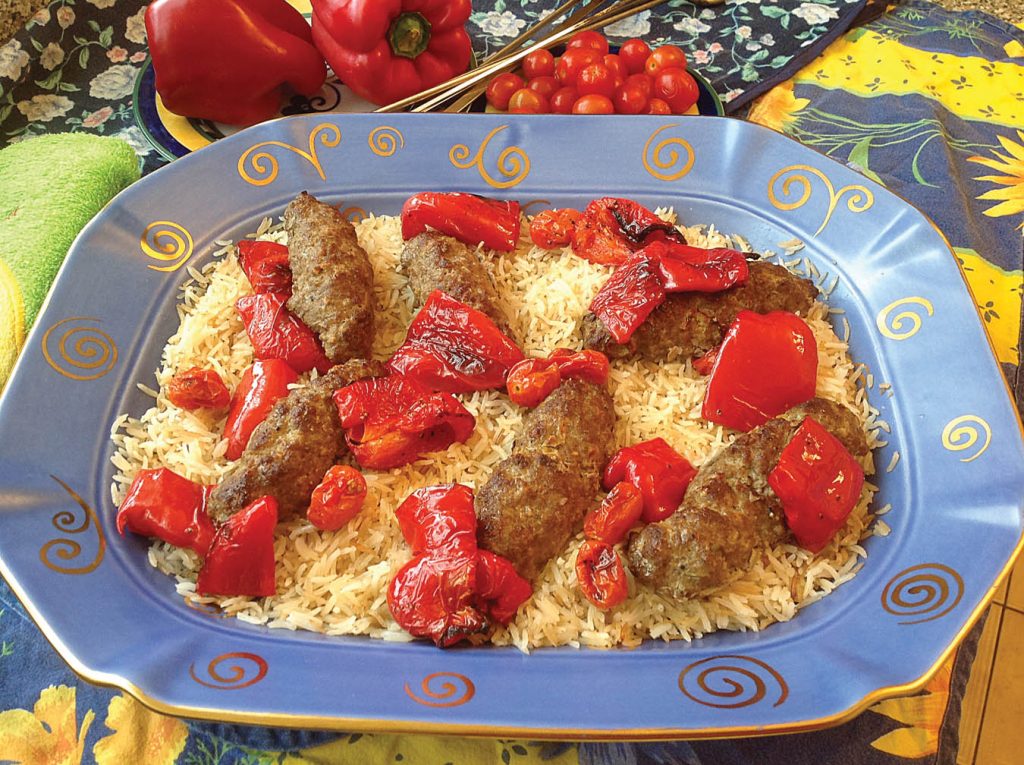
Ground meat kebabs
Chicken in pomegranate sauce – Fesenjan
Serves 6
This slightly tart dish from Iran should also be served over a dish of rice.
- 1 small eggplant (about 1 pound)
- 2 tsp. salt
- 4 Tbsp. butter
- 1 medium onion, finely chopped
- 1 pound boneless chicken breast, cut into ½-inch cubes
- 1 cup chopped walnuts
- 3 cups hot water
- 3 Tbsp. pomegranate syrup
- 1 tsp. black pepper
- 1 tsp. turmeric
- 6 Tbsp. cooking oil
- ¼ tsp. ground cardamom
Peel eggplant and cut into pieces about 3 inches long and ¼-inch thick. Sprinkle a half teaspoon of salt over pieces. Place in a sieve, topped with a heavy weight for one hour. Melt butter in a saucepan, then add onion and sauté over medium heat for eight minutes. Stir in chicken and stir-fry for four minutes, then add walnuts and stir-fry two minutes.
Add water, pomegranate syrup, salt, pepper, and turmeric, then bring to boil. Cover and simmer over low heat for 30 minutes. In the meantime, heat oil in a frying pan, then sauté eggplant until the pieces just begin to brown, adding more oil if necessary. Place eggplant on top of chicken, then simmer over low heat for 20 minutes, adding a little water if necessary. Stir in cardamom, then cook for five minutes longer.
Indonesian yellow rice – Nasi kuning
Serves 10 to 12
- 3 cups long grain white rice, rinsed
- 3 cups coconut milk
- 3 cups water
- 1 Tbsp. finely chopped fresh lemongrass
- 4 bay leaves
- 1 tsp. turmeric
- 1 tsp. salt
- ½ tsp. black pepper
- ¼ tsp. ground cloves
- ¼ tsp. cinnamon
- 3 Tbsp. butter
Place all ingredients, except butter, in a saucepan and bring to boil. Simmer uncovered for 20 minutes over low heat or until all liquid has been absorbed, stirring a few times. Turn off heat and cover. Let sit for 30 minutes. Add butter and fluff, then place on a platter and serve hot.
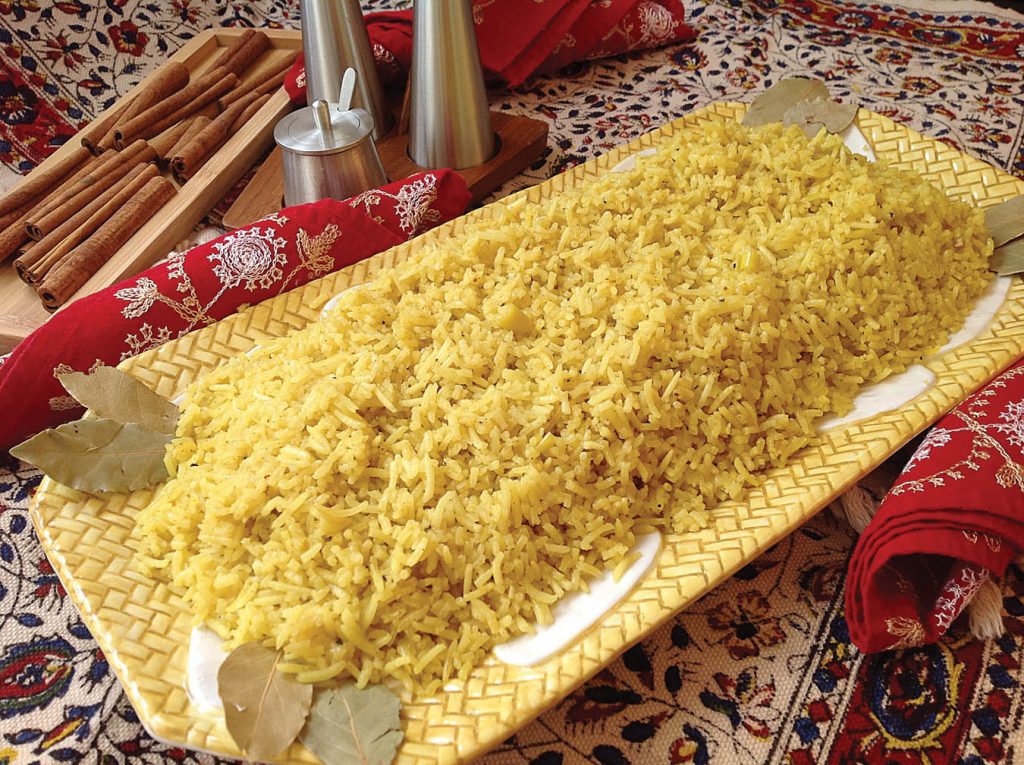
Indonesian yellow rice
Meat and chickpea soup – Hareera
Serves 10 to 12
Known as the Queen of Moroccan soups, hareera is made from available vegetables and meats and spiced to taste. For an exotic taste, serve with an accompanying plate of fresh dates.
- 4 Tbsp. butter
- ½ pound lamb or beef, cut into small pieces
- 2 medium sized onions, finely chopped
- 4 cloves garlic, crushed
- ½ cup finely chopped cilantro
- 1 can chickpeas (19 oz.), drained and rinsed
- 2 cups stewed tomatoes
- ½ cup green or brown lentils, rinsed
- 10 cups water
- 2 tsp. salt
- 1½ tsp. powdered ginger
- 1 tsp. paprika
- 1 tsp. black pepper
- 1 tsp. cumin
- 1 tsp. turmeric
- ¼ tsp. cayenne
- ¼ cup rice
- 4 Tbsp. lemon juice
In a large saucepan, melt butter then sauté meat over medium heat for 10 minutes. Add the onion, garlic and cilantro, then stir-fry for further 10 minutes. Stir in remaining ingredients except the rice and lemon juice then bring to a boil. Cover and cook over medium heat for 40 minutes, stirring occasionally. Stir in rice and cook for further 20 minutes, then stir in lemon juice and serve immediately.
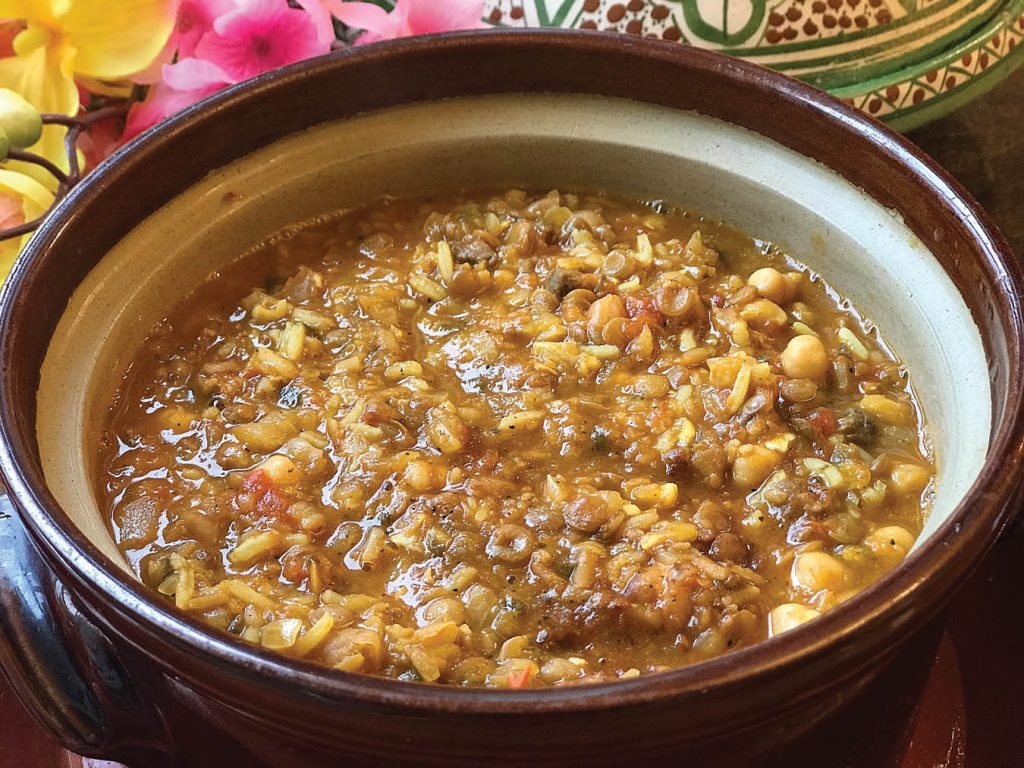
Meat and chickpea soup
Fish and noodles from Vietnam – Cha Ca
Serves 4
One of the ingredients is Nuoc Mam, a Vietnamese dipping sauce that can be purchased in any outlet that sells Asian ingredients.
- ½ pound thin noodles
- 2 Tbsp. Nuoc Mam
- ¾ tsp. turmeric
- 2 tsp. ground ginger
- 2 tsp. garlic powder
- ½ tsp. black pepper
- 2 Tbsp. vegetable oil
- 1 pound hard-flesh fish fillet, cut into medium pieces
- 1 cup chopped green onion
- 1 cup chopped fresh dill
- ½ cup chopped fresh basil
- 4 Tbsp. roasted peanuts, chopped
Cook noodles according directions on package, then divide into four serving bowls and set aside. In a bowl, combine Nuoc Mam, turmeric, ginger, garlic powder, pepper, and 1 tablespoon of the oil. Add fish and stir until all the pieces are coated. Place in a refrigerator and allow to marinate for 30 minutes. Heat remainder of oil in a wok or heavy frying pan until oil begins to smoke, then stir-fry fish for two minutes. Remove from heat, then stir in onion and half the dill. Top noodles in each bowl with fish, then cover with remaining dill and basil. Sprinkle with peanuts.
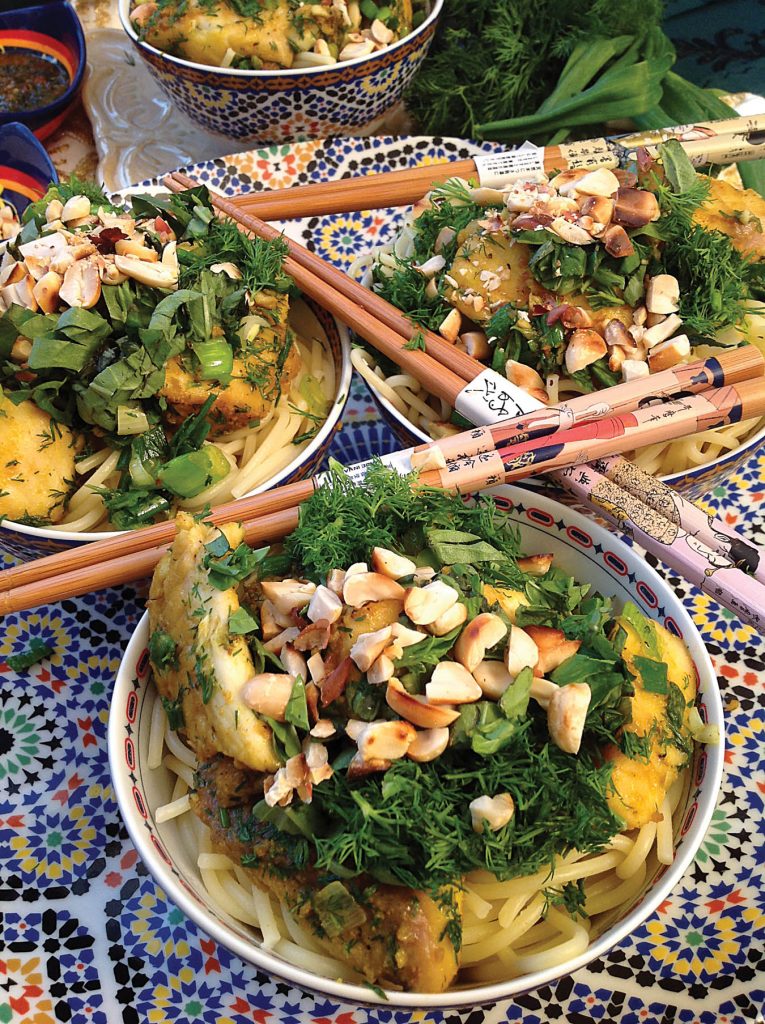
Fish and noodles from Vietnam
Meatballs with gravy from Kashmir – Rista
Serves 6
Best served over rice or mashed potatoes.
- 2 pounds ground lamb
- 1½ tsp. ground ginger, divided
- 1¼ tsp. ground aniseed, divided
- 1½ tsp. garam masala, divided
- 1½ tsp. salt, divided
- ¾ tsp. ground cardamom, divided
- 4 Tbsp. light sesame oil
- 6 garlic cloves, crushed
- ½ tsp. black cumin seeds
- 6 cups water
- ½ tsp. chili flakes
- ½ tsp. turmeric
- 2 Tbsp. dried onion flakes
- ¼ tsp. cinnamon
- Pinch of saffron
In a food processor, process lamb, 1 teaspoon of the ginger, 1 teaspoon of the aniseed, 1 teaspoon of the garam masala, 1 teaspoon of the salt, and ½ teaspoon of the cardamom for two minutes. Form into small, walnut-size balls, then set aside. To make the gravy, in a saucepan, heat oil, then add garlic and cumin seeds and stir-fry over medium heat until garlic begins to brown. Add water, chili flakes, turmeric, onion flakes, and remaining ginger, aniseed, and salt. Gently place meatballs in the saucepan with the gravy. Bring to boil, then cover and cook over medium-low heat for 50 minutes or until meatballs are well cooked. Add cinnamon, saffron, the remaining garam masala, and cardamom and gently stir. Cover and cook over medium-low heat for five minutes. Transfer meatballs and gravy to a serving bowl and serve immediately while hot.
Kashmiri fried lamb ribs – Tabak Maaz
Serves 4
- 2 pounds lamb ribs (after most fat has been removed)
- ¾ cup milk, mixed with 1 cup water
- 4 garlic cloves, crushed
- 1 tsp. ground ginger
- 1 tsp. aniseed
- 1 tsp. turmeric
- 1 tsp. cinnamon
- ⅛ tsp. ground cloves
- 1 tsp. salt
- 8 cups water
- ½ cup butter
Cut ribs into pieces 5 to 6 inches long and 2 to 3 inches wide, making sure that there are 2 or 3 ribs in each piece. In a saucepan, add all the ingredients except ribs and butter and stir together. Bring to boil. Add the ribs, then bring to boil and cover. Cook over medium-low heat for one hour or until the meat is tender, adding more water if necessary. Remove ribs with slotted spoon and set aside. Melt butter in a frying pan, then fry ribs over medium heat in two or more batches until they turn crispy and evenly browned. Serve while hot.
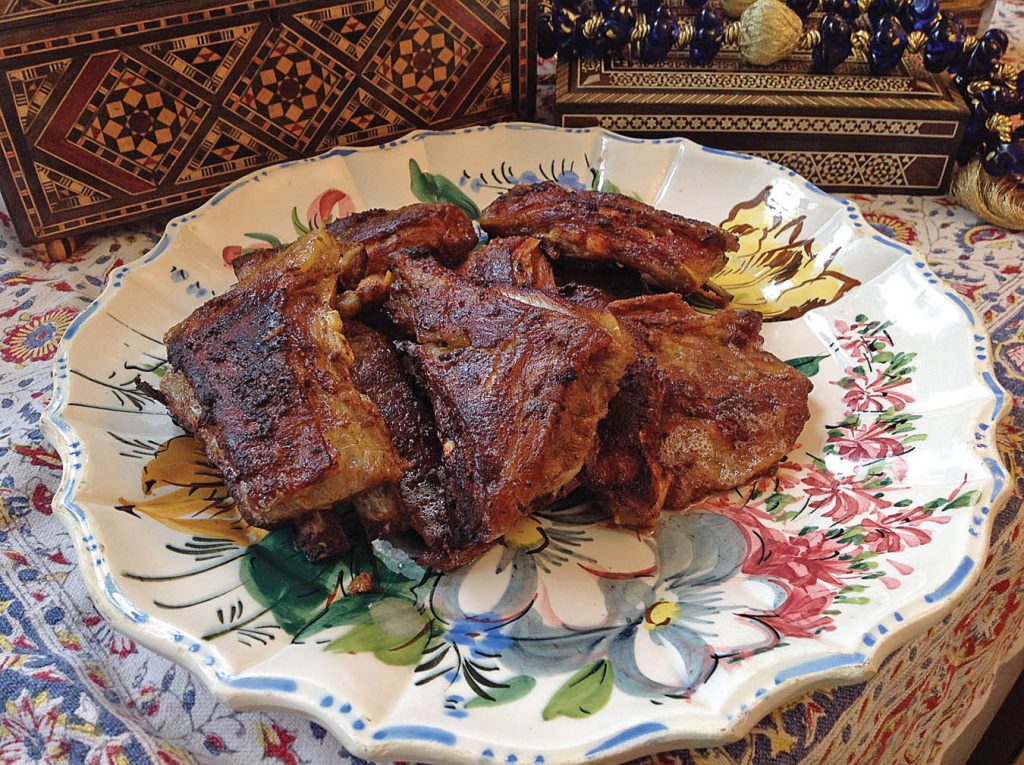
Kashmiri fried lamb ribs


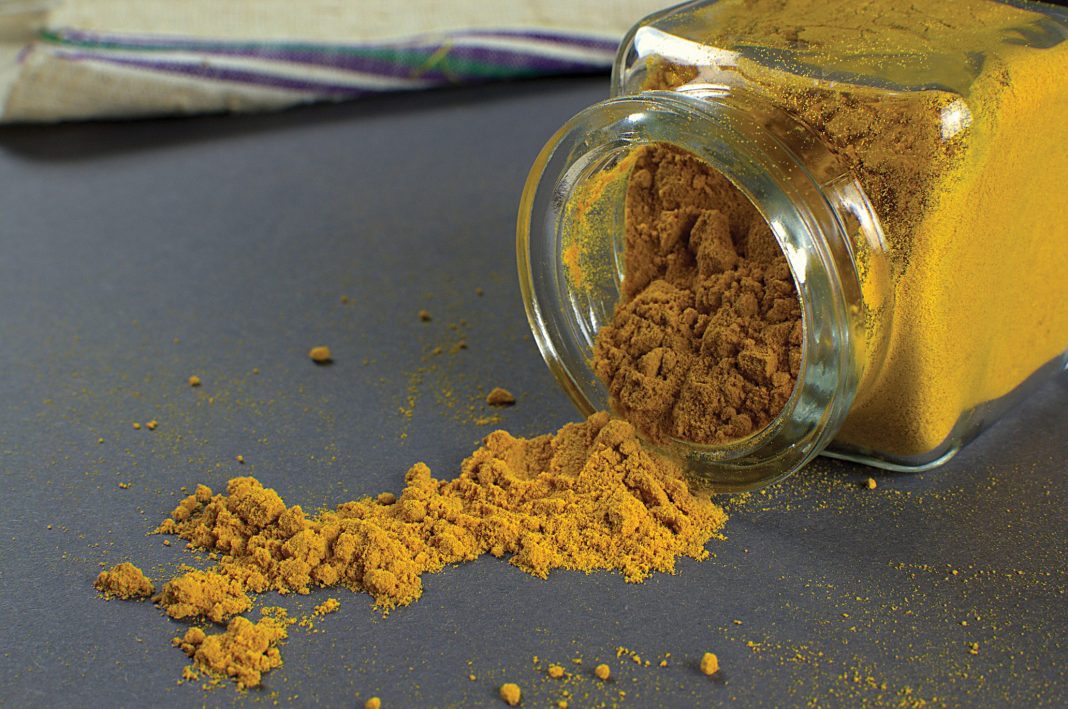







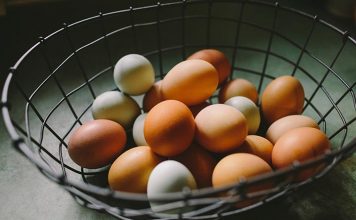


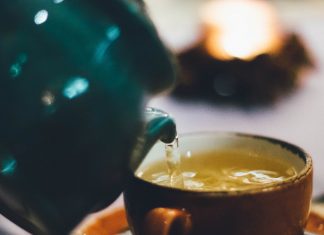
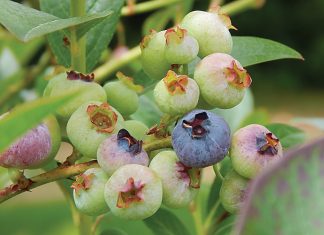
In response to the first commenter, isn’t it a bit of apples and oranges to compare post-surgical inflammation to typical age-related joint inflammation? I know in my own experience they are different. I also know turmeric appears to provide modest benefit in a reducing my own pains after a heavy workout or long, hill country hunting trips. Is it a miracle remedy? Far from it. But in my experience does provide some relief with no adverse side effects and at minimal cost.
Regarding the CMAJ “study” that Xan posted and refered to: The study looks at short duration (four days) of intervention, the commentators then cite a very specific surrogate marker (transient creatinine) and fail to recognize that neither the duration of hospital stay nor clinical events were affected. It states that this study negates all the other studies which looked at different aspects of turmeric and its compounds. It was NOT properly done, is not an unbiased prospective study with a large sample size, does not measure health outcomes over a significant period of time comparing individuals with higher versus lower levels of turmeric in otherwise healthy diets, where turmeric can be seen acting symbiotically with other food. If the writer of this study did the same type of research on any Rx or OTC drug they would get the same outcome and would have to come to the same conclusion. It seems that CMAJ with this article/study is standing with pharmaceutical medicine in attempting to discredit non-pharmaceutical interventions.
While tasty, the medical benefits of Curcumin have been disproven in recent studies. The more robust the study, the worse the results. Many of the earlier studies were done by supplement manufacturers. It’s a textbook example of bad supplement science.
This Canadian article sums it up well. Even if it did work, less than 1% is absorbed through the stomach.
https://www.cmaj.ca/content/190/43/E1270